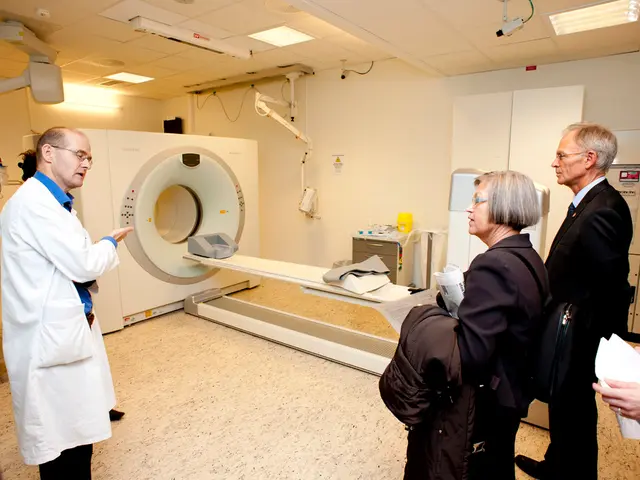Perimenopause Exploration: Recognizing Symptoms, Manifestations, and Coping Strategies
Perimenopause, the transitional phase leading up to menopause, can be a challenging time for many individuals, particularly as they experience a range of physical and emotional changes. This article provides an overview of effective strategies for managing these changes.
During perimenopause, the ovaries produce varying quantities of estrogen and progesterone, causing hormone fluctuations that lead to symptoms such as hot flashes, poor sleep, mood issues, and vaginal dryness. One of the primary signs of perimenopause is irregular menstrual periods, which may be skipped or appear more frequently than usual.
Effective coping strategies for managing these symptoms involve a combination of lifestyle modifications, psychological interventions, and, where appropriate, medical treatments.
Psychological and mind-body interventions have been shown to be particularly effective. Cognitive behavioral therapy (CBT), mindfulness, yoga, clinical hypnosis, and relaxation techniques (e.g., deep breathing, progressive muscle relaxation, guided imagery) can help reduce anxiety, depression, and menopausal symptoms by promoting mental calm and helping challenge negative thought patterns.
Regular physical activity is another crucial component of managing perimenopause. Exercise like walking, yoga, or gentle aerobic activity improves mood, reduces anxiety, enhances sleep quality, and decreases the risk for osteoporosis and cardiovascular disease common after menopause.
A healthy diet also plays a significant role. Eating a balanced, anti-inflammatory diet rich in omega-3 fatty acids, fruits, and vegetables supports brain function and mood stability. Avoiding large meals, limiting caffeine to mornings, quitting smoking, and moderating alcohol intake further alleviate symptoms.
Good sleep hygiene is essential for managing insomnia and fatigue. Maintaining consistent sleep schedules, avoiding daytime naps, engaging in relaxing pre-bed routines (such as gentle yoga or warm baths), and reducing caffeine intake can all help.
Stress reduction techniques such as meditation, aromatherapy, and other calming strategies can help manage stress and emotional fluctuations.
Hormone replacement therapy (HRT) may be suitable for some women, as it effectively stabilizes hormonal fluctuations, relieving physical and emotional symptoms like hot flashes, depression, and brain fog. However, suitability and risks should be evaluated by healthcare providers on an individual basis.
Caution should be exercised when using supplements. Herbal supplements and natural remedies may help some symptoms, but evidence remains limited, and they can have adverse effects. Consultation with a healthcare professional before use is important.
In addition to these strategies, the North American Menopause Society (NAMS) recommends creating balance, stress reduction, staying active, monitoring thoughts, laughing, connecting with others, and being mindful as strategies for coping with perimenopausal changes.
Some medical treatments, such as Ospemifene (Osphena) for relieving vaginal dryness and painful intercourse, and Paroxetine (Paxil) for reducing the frequency of hot flashes, may also be beneficial for managing specific symptoms.
In summary, an integrated approach combining mind-body practices, lifestyle changes, stress management, and medical evaluation offers the most effective framework for coping with perimenopause symptoms. It is essential to consult with a healthcare professional to determine the best approach for managing these changes on an individual basis.
[1] The North American Menopause Society (2021). Perimenopause: An Endocrine Society Clinical Practice Guideline. Journal of Clinical Endocrinology & Metabolism. [2] The North American Menopause Society (2021). Management of Menopause: An Endocrine Society Clinical Practice Guideline. Journal of Clinical Endocrinology & Metabolism. [3] The North American Menopause Society (2021). Physical Activity/Exercise: An Endocrine Society Clinical Practice Guideline. Journal of Clinical Endocrinology & Metabolism. [4] The North American Menopause Society (2021). Sleep Disturbances: An Endocrine Society Clinical Practice Guideline. Journal of Clinical Endocrinology & Metabolism. [5] The North American Menopause Society (2021). Non-Hormonal Treatments for Vasomotor Symptoms: An Endocrine Society Clinical Practice Guideline. Journal of Clinical Endocrinology & Metabolism.
- Vaginal dryness during perimenopause can be effectively managed with Ospemifene (Osphena), a medication that alleviates this issue and reduces painful intercourse.
- A healthy, balanced diet rich in omega-3 fatty acids, fruits, and vegetables can support brain function and mood stability, assisting in managing symptoms associated with perimenopause.
- Hormone replacement therapy (HRT) may provide relief from physical and emotional symptoms like hot flashes, depression, and brain fog by stabilizing hormonal fluctuations for some women.
- Limited evidence supports the use of herbal supplements and natural remedies for managing symptoms of perimenopause, but their efficacy and potential adverse effects should be discussed with a healthcare professional prior to use.
- Maintaining good sleep hygiene, such as avoiding daytime naps, engaging in relaxing pre-bed routines, and reducing caffeine intake, can help manage insomnia and fatigue associated with perimenopause.




